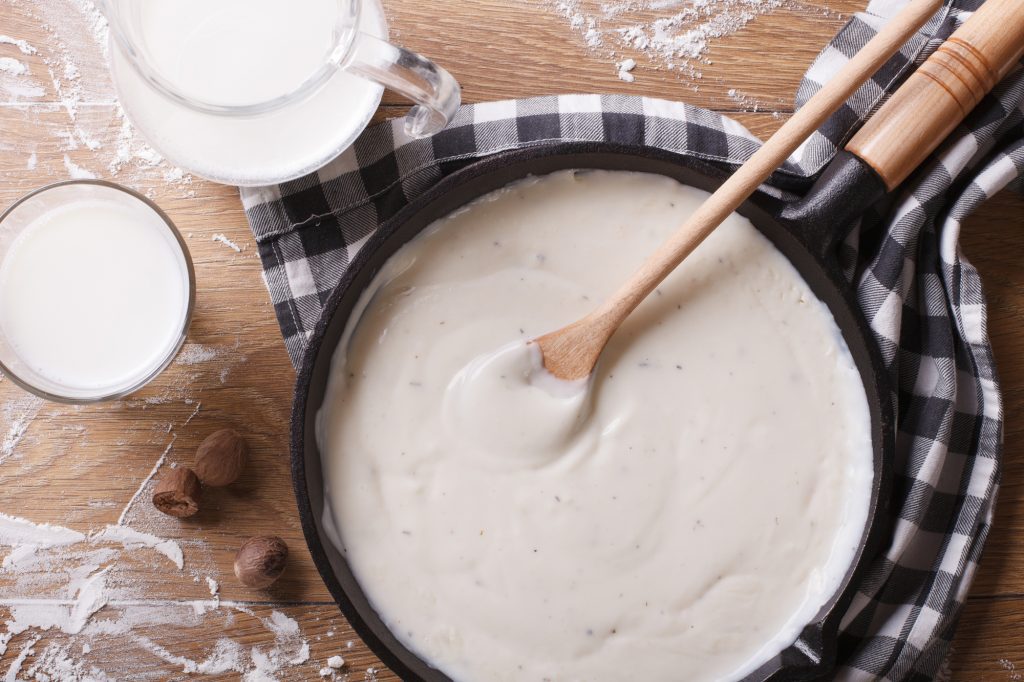There are 4 major groups of basic French sauces: milk sauces (bechamel-based), velvet sauces (veloute-based), whipped sauces (butter-based and emulsion-based), and brown sauces (brown stock-based). I have targeted two of these major groups for the first time: whipped and brown sauces.
Butter sauces
Beurre blanc
classic butter sauce, creamy, warm emulsion with an acidic taste. It is made by reducing the shallots with white wine vinegar and white wine, then adding 40dkg of butter per cube (to an initial 3dl of liquid), while stirring the reduction continuously. Be careful not to overheat the butter (50-60 degrees ideal), otherwise, the sauce will fall apart. (If this happens, adding a little cold water will save the situation.) The technique is to add cold butter to the hot liquid while stirring continuously so that it forms an emulsion with the reduction while the heat is being equalized. Ideal sauce: for fish
Beurre rouge
instead of a white butter sauce, this is a red butter sauce, with the noble simplicity of replacing the white wine and white wine vinegar with red wine in the above recipe. Perfect for vegetables, light roasts, and steaks.
Hollandaise sauce
also a warm, stable emulsion butter sauce, here egg yolks are used. To make it, you need clarified butter. Start whisking the egg yolks in a saucepan over steam with a whisk, then when the yolks resemble the consistency of a softer sour cream, add the clarified butter slowly, like oil in a mayonnaise. If the emulsion gets too hot and falls apart, cold water can be used to help it along. Season with salt, pepper, lemon juice, and white wine vinegar. A classic mistake is to end up with scrambled eggs because the temperature is too high. It is best to cook it as slowly as possible, boiling the water underneath over low heat. A classic accompaniment to poached eggs, salmon or asparagus dishes.
Bearni sauce
a version of hollandaise sauce, in this case, a white wine reduction with shallots is added to the egg yolks, and when the sauce is ready, freshly chopped tarragon is added to taste. It is considered an essential sauce in English steakhouses.
Foyot sauce – a further mutation of bearni sauce, where veal glace is added to the finished sauce. Serve with veal.
Choron sauce
Also based on bearni sauce, but flavored with tomato puree and Worcestershire sauce. It goes perfectly with egg dishes and roast beef.
Brown basic sauce
The perfect brown gravy base – whether made from poultry, veal or game – is a clear, intense, dark brown gravy base. In addition to the main ingredient (chicken, game, etc.), it contains a bouquet Garni (a bouquet of fresh herbs, typically parsley, bay leaves, thyme, and marjoram), vegetables (carrots, celery root, onions, fresh tomatoes, stalk celery and even leeks) and a gelling agent (chicken feet, wings or even calf feet). And, of course, water. Don’t forget that.
Preparation:
- Bake the bones, and trimmings in a baking pan at 180 degrees for at least an hour, until they are a nice dark brown color.
- In a saucepan, fry vegetables thoroughly, except the tomatoes.
- Add the tomatoes, browned meat, and bones, then the bouquet garnish and pour over cold water.
- Simmer slowly for at least 5 hours.
- Strain and ready to use as a sauce base.
Glace
The simplest use of our basic juice, although I would dispute its popularity in terms of taste. To make glace, simply boil your stock. If there wasn’t enough gelling agent in the stock, you will need starch.
Jus
Perhaps one of the most widely used uses of brown stock. Once you have the base juice, you’ll need a few tricks to convert it into jus.
1.Sauté chopped shallots in a little oil.
2.Pour in a little red wine, add bay leaves and whole pepper, then bring to the boil.
3.Pour in the red wine again and bring to the boil.
4.Repeat the process until you get a nice dark reduction.
5.Add the brown stock and boil to the desired sauce consistency.
6.Strain through a fine sieve.
Green pepper sauce
Also in the West, green pepper sauce has a huge audience when it comes to steaks. And the basis of a good green pepper sauce is good jus.
1. Start by browning the green pepper in a dry pan.
2. Pour in a little whisky or brandy and red wine, then reduce.
3.Add the already prepared jus and boil once.
4.The combinations of sauces and their names are almost endless since in literature there are separate paragraphs devoted to Burgundy, Port, and Madeira sauces, the only difference being the wine that is reduced with the brown stock.
Roast meat juices
Roast meat juices is perhaps the quickest improvised sauce to make, and it is no coincidence that it dates back to Roman times.
- Slowly fry the tomato paste in the leftover fat from the roast until it turns a rusty brown.
- Sprinkle with flour and continue to fry gently.
- add liquid (water, a little stock, broth, bone broth)
- Season and taste
Mustard meat juices, seasoned with mustard and a little red wine, for roast pork.
Lemon mash: seasoned with lemon juice and zest for veal roasts.
French meat juices: flavored with white wine, the perfect choice for poultry.
Besamel
The name béchamel may sound familiar even to the layman, as it is the basis of many sauces that many housewives make at home. Its composition varies from country to country, but the basic ingredients are constant: butter, flour, and milk. The classic spices are white pepper and nutmeg. But in England, it is common practice to boil the milk with onions, garlic, cloves and bay leave beforehand to give the sauce a stronger and richer flavor, and in Germany, at least the bay leaf is added.
The story goes that the original sauce was first made at the court of Louis XIV by Loius Béchamel in the early 1700s. No wonder, then, that over the centuries each kitchen has adapted a little to its own tastes.
Béchamel can be used as a basic sauce on its own (for example, in lasagne), but it is also used to make Mornay sauce (flavored with egg yolk and gruyere or Parmesan cheese, 1880, Monsieur Voiron, Paris), Soubise sauce (made by boiling onions in butter and then brushing them over), and is a must for cooking in the oven (gratin) and making savory soufflés.
I probably wouldn’t spend too much time on this recipe, as it involves pouring a simple buttery stir-fry (roux blanc) over hot milk. The proportions are worth knowing, 1 liter of milk requires 60 grams of butter and 60 grams of flour for light cream. Depending on how you use it, this ratio may vary. While 60-60 grams per liter is the basis for a sauce, 75-75 for gratinating, and 150-150 for puffed up.
Let’s look at possible mistakes.
- The milk burns off. Yes, I know this seems very basic now, but according to unofficial statistics, 9 out of 10 Besamel deaths are caused by milk burns. Constant stirring.
- The sauce will be lumpy. Cold or hot, if you pour all the milk into your scrambled eggs at once, or if the milk is too cold, it can easily become lumpy. To avoid this, add the milk while stirring constantly. And if you’re too late to prevent it, a sieve through a sparge sieve will save everything.
Velouté
If you’re already making béchamel, then velouté is just an extra. While with besamel you pour hot milk over your light, buttery scramble, with velouté you pour the base juice. The proportions (60-60 grams of butter-flour, 1 liter of liquid) are also correct. There are so many uses for velouté: it goes with poultry, veal, vegetables, or fish.
Auguste Escoffier
And now that we’ve gone through the other four categories, with the exception of tomato-based sauces, it’s worth saying a few words about Escoffier. He is the man responsible for the categorization of sauces: in his book Le Guide Culinaire (1903), which contains nearly 5,000 recipes, he classified sauces. The kitchen brigade system (with a chef de partie at the head of each section) is also the work of Escoffier. In addition, modern catering today, thanks to him, has gone from the French way of serving (all the dishes on the table at once) to the Russian way of serving (dishes one after the other), which is still used today. But if we are talking about Peche Melba or Rossini steak, we also owe Escoffier a debt of gratitude.
Last updated: September 24, 2023


